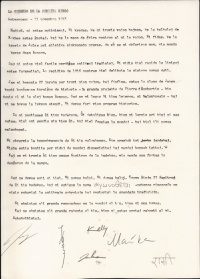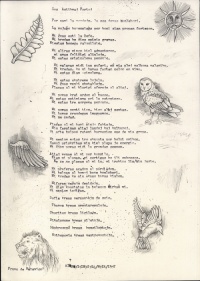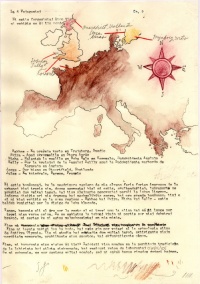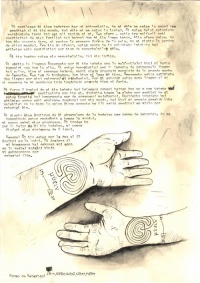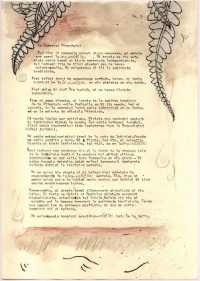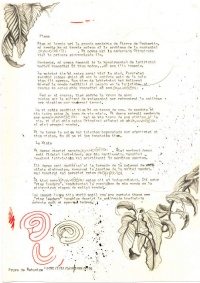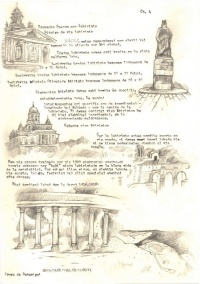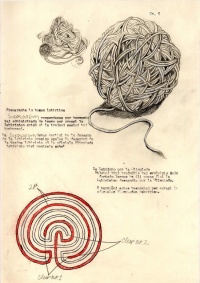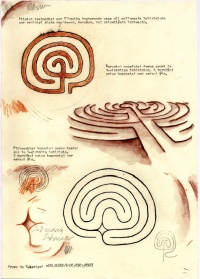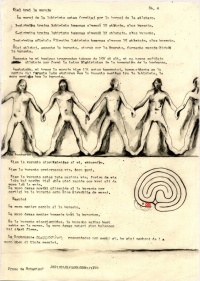Codex-English
From LostRing
The Codex of the Lost Ring
[edit]
English
- Message from Jorge's six
(translation by thebruce)
- The Codex of the Lost Ring
- Antwerp - 11 November 1918
- Today, we're optimistic. We believe we've found a way home, that the calculations of Rakhee are right, and that Akira's map will show us the way. We trust that Jules' theory about athletic synchronization is right, so even if we start to leave now, your world will have a second chance.
- But we know how easily ancient traditions are lost. We saw how quickly (the limitations) were forgotten. The recidivism of 1916 shows how delicate the system can be.
- We've taken 27 years in order to find our way, and finally, (it was Jorge's plan that caught a lucky turn of history) Jorge's plan for good luck to change history - Pierre de Coubertin's big project - gave us the best chance. But if you're reading this letter, we failed - and you will not have the luxury of waiting. You will have to write your own history.
- So we leave behind this Codex. It details everything, what we learnt about the six of us, why we were sent here, and how the worlds works - and how we could fail.
- We saw the consequences of this failure. During almost three decades, Micha was haunted with sights of broken worlds (worlds torn asunder ?) and worlds crushed. And if you found this first chapter of the Codex, your world is now in danger of dying.
- But it doesn't have to be this way. You can help. You must help. Find all 27 chapters of this Codex, and you'll be the new
{agonothetai} - powerful ring-leaders in a mission to recover the ancient secrets and bring back the grand traditions!
- There does not exist a greater responsibility in this world, that what you have now.
- And there isn't a bigger story than that which we're ready to give to you.
- Signed,

- (signatures - Kelly, Micha, Jules, Jorge, Akira, Rakhee)
[edit]
English
- Chapter 1: Six Ancient Strengths
(translation by thebruce, polished by esperanto-tim)
- Six ancient strengths
- To save the world, the six must work together.
- The journey begins with knowing one's own strength.
- I like being the boss.
- I believe that everyone's opinion is important.
- I'm an excellent story teller.
- I approach a life like it's an adventure.
- I like to please other people.
- I am an original thinker.
- I hate to see somebody suffer, even my worst enemy.
- I believe that I have a strong goal in a life.
- I am always curious.
- I am extremely loyal.
- I like overcoming obstacles.
- I like to clarify matters to others.
- I can create order out of chaos.
- I am optimistic about the future.
- I am a very careful person.
- I can empathize with others.
- I have a huge imagination.
- I do not yield.
- I like to have all the facts.
- I'm fascinated by other lands and cultures.
- I often help to retain harmony in my group.
- I am never too busy to help a friend.
- People describe me as full of energy.
- I can always see the big picture.
- Others come to me for advice.
- When I plan, I make sure that they succeed.
- Even if I don't like someone, I deal with them fairly.
- I prefer action to a words.
- I help others cooperate well.
- I believe that everything happens for a reason.
- I make wise decisions.
- I always see the beauty around me.
- I am never bored.
- Sofia creates seekers of knowledge.
- Thumos creates adventurers.
- Chariton creates links.
- Dikaiosune creates leaders.
- Sophrosune creates counsellors.
- Mythopoeia creates truth-finders.
- Proof of recovery: AI7P/I5DB/J2L4/N2IR/I80T
[edit]
English
- Chapter 2: The 6 Travellers (1/2)
(translation by Limako)
- The 6 travelers Ch.2
- We had forgotten everything when we woke up in this world.
- Rakhee -- In a church courtyard in Trojaborg, Sweden
- Akira -- Near a water mill (wheel) in Stora Anrås
- Micha -- Behind the mill en Rocky Valley, Cornwall, Southwest England
- Kelly -- On the cliffs of the archipelago of Scilly, near the southwest coast of Cornwall in England
- Jorge -- On a farm in Stuartfield, Scotland
- Jules -- In a cathedral, Bayeux, France
- We were lucky, that the unusual manner of our arrival made a strong impression on the cityfolk who found us, half naked as we were, blindfolded, and reportedly unresponsive for several days and even then mostly unable to speak the local language. Information spread regarding our dramatic and unexplained appearance, and through great good fortune, those of us who awoke in the same region -- Rakhee and Akira, Micha and Kelly -- were soon brought together through distribution of local gossip.
- However, it took more than a year for the rest of us to find one another and even longer for us to discover our true goal. If we hadn't had the tatoos on our right arms, I'm certain we would have been unsuccessful in our mission.
- In the end, we learned to navigate using the code and used it to travel to the archeological site at Ancient Olympia. There we studied and questioned for many years, activating our lost memories, practicing our sport, and laying our plans.
- Finally, we understood our mission like this: initiate your world with the lost traditions of the labyrinth and athletic synchronization, and restore a network of
{omphaloi}. If we succeeded, we would save not only many worlds, but also have the resources to return home.
[edit]
English
- Chapter 2: The 6 Travellers (2/2)
(translation by Limako and Verdulo)
- We left this Codex behind us because we realized, that we were possibly not the first six sent to this world, and maybe not the last either. We want to help future travellers learn and act more quickly than us. One thing -- it was very difficult to be separated from our families and homes during this long time. Another thing is, that with each passing year, we carry the heavy burden of the knowledge that we risked the loss of other worlds. Because of those two things, it is imperative that some future initiation and activation be sped up by as many memory aids (as) possible.
- This codex is your memory aid, and your clue.
- We chose the language Esperanto for this text because of the difficulties we had communicating with each other. We are encouraged by the invention of a universal language, and intend, when we come back home, to write our own versions of the great work of Szmurlo. With a bit of good luck, by the time you read this, Esperanto will have become a second language for all universal travelers. Since it is still a new language for us, we hope you will forgive some translation errors which we made.
- We are making seven copies of this text and intend to come home with one text each, leaving one behind here, spread out across the globe to ensure that it will be found and understood only by travelers of the same type. Accidental initiation and activation could be extremely dangerous for your world, and therefore we have tried to make it almost completely impossible for someone to have the knowledge herein unless they were sent on a mission to get it back.
- We have signed every chapter of this copy with a proof of recovery, so if communication is restored across the worlds, we will be able to follow your progress. We believe that by help of this codex, you will be able to complete your mission within 5 years.
- Remember, this is only the second of 27 chapters in the codex. We wish you good luck and safe travels in the vast voyages which you are undertaking to get them back.
- Proof of recovery: JR01/SPL7/AG2I/JR28/1FB7
- Translator's note: the word for "recovery" here (rehavigi) has a suffix (-ig-) which might imply getting something back for someone else, not for yourself.
[edit]
English
- Chapter 3: The Secret Ringmasters (1/2)
(translation by esperanto-tim)
- As soon as we started to get our memories back, we set off to search for the Agonothetai. We believed that our main mission was to search for these secret game-keepers and inform them that their efforts keep failing for some reason. We would reteach them the ancient traditions.
- After several years of unsuccessful searching, however, we had to conclude that the Agonothetai no longer existed in your world.
- How is this possible? Until this day, we don't have clear answers.
- When we first arrived, we learned that the ancient tradition of the Olympiad had been [lost/abandoned] in this world. But we hoped that the secret games were continuing in some form, even in the absence of the official Olympics.
- We had a reason for our optimism. It surprised us to come across hundreds of labyrinths across the world. Some were several hundred years old. Others dated from as recently as the last several decades.
- We were enthused to find that the art of labyrinth making had not been lost -- on the contrary, it was flourishing. But we were curious as to who was making these labyrinths, and why, if not the Agonothetai.
- All indications now lead us to the belief that the crucial aim of the labyrinth – to link the worlds and enable athletic synchronization – was not only completely forgotten in your world; it had been consciously destroyed many centuries previously, forcing a few to continue the tradition in secret.
- We don't know what happened to the few who continued the responsibilities of the Agonothetai in secret. What we do know for certain is that no-one is left today to essential task to save the worlds.
- We of course tried to find allies sympathetic to our cause. We went to no less than Herculean lengths to persuade historians, archaeologists and local chiefs everywhere we traveled of the need to understand the ancient traditions. However, with such a paucity of evidence on my part, the six of us were unable to convince more than a few.
- We failed to construct new Agonothetai worthy of the task.
[edit]
English
- Chapter 3: The Secret Ringmasters (2/2)
(translation by Tim)
- Plan:
- When we learned of the great project of Pierre de Coubertin, we thought we had found a solution to the problem of the missing Agonothetai. We could use the modern Olympics as a primary means of synchronization.
- At the same time, we could depend on the labyrinth builders today to organize this world*... even without their knowledge. [*Translator's note: the word here is given as "modo" in the original and means "fashion", but is probably a typo, and should say "mondo", i.e. "world". I've put "world in my translation above.]
- The little paths here are the same as ours. Parallel journeys would seem to be possible, even without the ancient knowledge of the aim which they serve. With so many labyrinths and cultures around the world dedicated to passing into labyrinths, we believe that it's possible to organise even without Agonothetai.
- But if we're wrong, then the task of creating a new [gap in original text] will undoubtedly rest on the shoulders of travelers, to reconstruct the ancient organization* for modern times. [*This word actually appears in English, not in Esperanto, in the original; probably just a typo.]
- If you were sent here in a team of six, then undoubtedly this task will be the core of your mission. You must recruit members for a new Agonothetai and if your team of six is similar to ours, you are most probably Olympic athletes, or ever Agonothetai from your own worlds.
- You do have the required knowledge and talent required to carry out this mission, whether or not you are aware of it yet.
- The Mission
- You must establish new Agonothetai. [Note that "Agonothetai" is plural here, but I don't know what the plural is in English – "Agonothetais", or something else?] Their members must be trusted individuals, on all continents, capable of building labyrinths and practising the lost sport.
- They must be dedicated to the learning of the science of athletic synchronization, must understand the theory of the many worlds, and must build and secure a network of Omphaloi.
- These new Agonothetai will be more than game-keepers. They will be "ring leaders"* guiding your world's journey back to the synchronized ring of many worlds. [*Note: the words "ring leaders" appear in English, in quotes, in the original document.]
- You cannot leave this world until you are certain that these new "ring leaders" * are capable of secretly continuing the ancient traditions after you have gone home. [*Strangely, the first 14 words of this paragraph, i.e. You cannot ... "ring leaders", appear in English in the middle of all the Esperanto in the original document.
- Proof of recovery: 25MC/I2YJ/LAH5/I8MR/R72S
[edit]
English
- Chapter 4: Finding space for the labyrinth
(translation by Nicolas)
- Finding Space For a Labyrinth
- Situating Your Labyrinth
- Χαρις [Kharis, in Greek letters] are responsible for choosing and communicating the sites for labyrinths.
- A training labyrinth can be created in some smooth, open place.
- A 3-circuit training labyrinth needs a playing space of 12x14 feet.
- A 5-circuit training labyrinth needs a playing space of 18x22 feet.
- A 7-circuit Official Olympic labyrinth needs a playing space of 26x30 feet.
- A synchronizing labyrinth must be created at a special, predetermined place. The worlds will agree about a specific set of coordinates - longitude and latitude - for the center of the labyrinth. You must center your labyrinth at these chosen coordinates, or the synchronization will fail.
- Hiding your labyrinth
- Because your labyrinth is a lost sport in your world, you must find places, where you will not draw undesired attention to your creation.
- During our own training for our 1920 synchronizing event, we found success by "hiding" our labyrinths in the clear view of the un-initiated. To escape their sight, we chose places where sport, playing, festivals and other special events often take place.
- Our training places during the years 1916-1918:
- Proof of recovery: MB53/2hNK/33Ah/Zh72/KAV3
[edit]
English
- Chapter 5: Preparing the human labyrinth (1/2)
(translation by not attributed)
- Preparing the human labyrinth
- Dikaiosune are responsible for putting together and administering a team to arrange the labyrinth before training sessions and competitions.
- The dikaiosune must be sure the design of the labyrinth is precisely equal to the design of the training labyrinth or the official Olympic labyrinth as shown below: (design showing red lines, identified as "clew no. 1", and white lines, identified as "clew no. 2" with a note indicating that they are separated by 2 ft.)
- The labyrinth for the Olympics
- Athletes that are trained and develop their strengths will learn that they can finish the labyrinth designed for the Olympics. 8 turnings are needed to escape the official Olympic labyrinth.
[edit]
English
- Chapter 5: Preparing the human labyrinth (2/2)
(translation by not attributed)
- Athletes training for Olympic competition use shorter labyrinths to develop their speed, courage, and sense of direction (literally "becoming oriented cleverness").
- First-time runners must try the 3-circuit labyrinth. 4 turnings are needed to escape it.
- More experienced runners can train on the 5-circuit labyrinth. 5 turnings are needed to escape it.
- (hand written note: The 5-circuit labyrinth).
- Proof of Recovery: 9JRL/ADIM/I0OC/JMC2/KMHI
[edit]
English
- Chapter 6: How to create the walls
(translation by limako)
- How to create the walls
- The walls of the labyrinth are formed with athletes' bodies.
- A 3-circuit training labyrinth needs at least 10 athletes, plus the runner.
- A 5-circuit training labyrinth needs at least 12 athletes, plus the runner.
- A 7-circuit official Olympic labyrinth needs at least 15 athletes, plus the runner.
- All athletes, except the runner, stand on a string, forming walls around the runner.
- Unless you assemble a very large team of 150 or more, you will not have enough athletes to make the entire labyrinth at the beginning of the competition.
- Instead, you will create the walls when they are needed, beginning in the center and accordingly outward. While the runner moves through the labyrinth, the wall moves with the runner.
- During competition
- When the runner approaches you, start to turn.
- When the runner goes by you, cease humming.
- When the runner is completely past you, leave your place and move along the way.
- The wall has to move faster than the runner to ensure that the the runner is always surrounded by walls.
- Rules
- The wall should never speak to the runner.
- The wall must never intentionally touch the runner.
- If the runner becomes disoriented, the runner may run directly into the wall. The wall must maintain its balance and stand firm.
- The Sophrusune {greek} is responsible for ensuring that all members of the wall obey these rules.
- Proof of Recovery: JKC7/C8JB/5ARH/MBM2/3ITE
